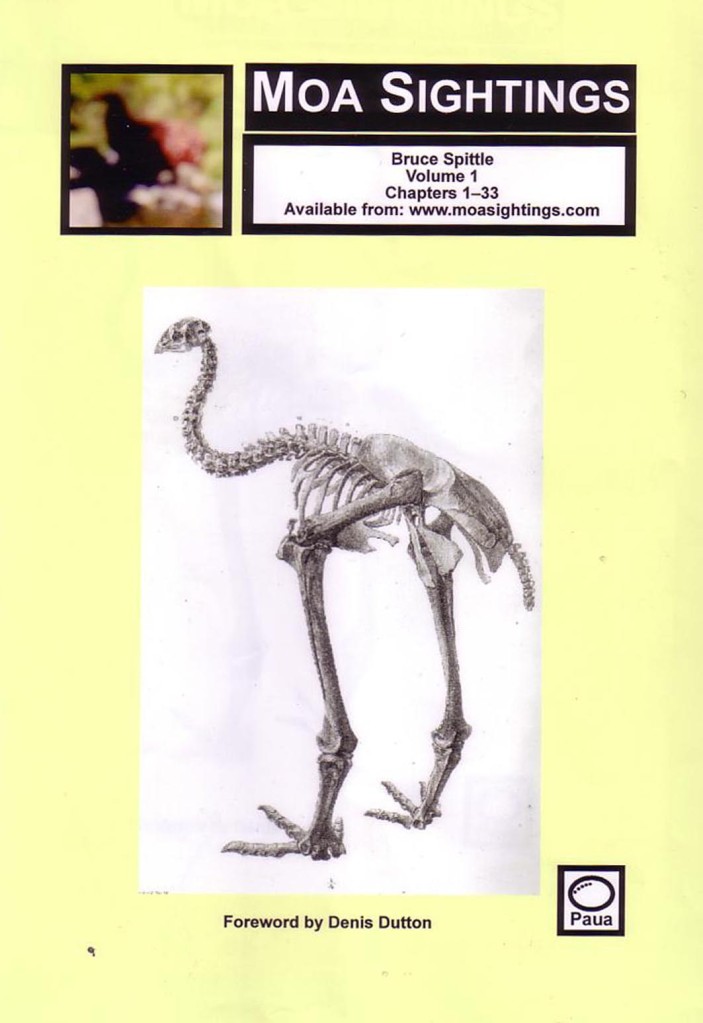Review: Moa Sightings December 22, 2010
Author: Beach Combing | in : Contemporary, Modern , trackback[automatic reserve post]
When Beachcombing was just a wee sprog, he used to read books and be transported to other worlds. Those were the times when three hundred pages written by John Buchan, Evelyn Waugh or Enid Blyton could set off fire balls in his head. But then Beachcombing lost his innocence – schooling and Cambridge to blame – and the thrill of reading disappeared, like Wordsworth’s vanishing sense of wonder at nature.
Certainly, it is only very rarely that Beachcombing now reads a book that brings him back to the ten-year-old biting his lip, curled up under the duvet: one that connects the intellect with the emotions and then drills into his subconscious. And most recent example, after a couple of quiet years in reading terms, has been Bruce Spittle’s Moa Sightings.
Now the Moa for the unlucky ones who don’t know is the giant flightless bird that used to dwell in New Zealand – Beachcombing recently wrote a post on an alleged nineteenth-century sighting. The debate about the Moa is not whether or not it existed. It did – there is no question. Its bones can be found through much of New Zealand. But rather when the Moa died out.
Scholarly opinion is constantly evolving here, but most would pick a date about 1400 AD for the last Moa death. Others suggest that in some hidden corners of the island the bird survived until 1800 and the first European settlements. Then there is too a tiny minority that believe that even today, down some darkened creeks…
Bruce Spittle has clearly, and in the nicest possible way, lost his head over the question. His work is an epic publishing endeavour. Three exquisitely-produced volumes with the most luscious colour illustrations and stitched spines.
Damn it, Beachcombing’s hands began perspiring as soon as he saw them unpacked on his study desk!
In the three volumes, the author has gathered one hundred and fifty sightings from modern times, 1500 (!) to 1993 (!!). He has then brought every possible source to bear on these individual sightings to assess whether or not they can be trusted.
Each chapter or sighting follows the same rigid structure: ‘introduction’, ‘claim’ and ‘discussion’ with maps and, when relevant, photographs. If the subject was less inherently interesting then this structure would be deadening. But, instead, the combination of Moas, proud Maori and colonial sorts is adventuring crack for the sensation-greedy armchair traveller.
So how do we explain all the various sightings of the Moa, particularly, in the last two hundred years given that these birds were supposed to have disappeared long before Columbus sailed the ocean blue?
Beachcombing is now half way through the three volumes and – with the exception of a handful of cases where jokes and dishonesty were perhaps at play – would formulate three explanations: (i) Survival, (ii) Maori identity and (iii) Colonial angst.
(i) ‘Survival’: the bird actually made it through the Maori settlement of New Zealand and, indeed, squawked for several centuries more. This is the one that Beachcombing wants to believe, but that he can’t quite bring himself to sign up to – particularly not the idea that the Moa still lives today.
Dry-as-dust cowardice?
Perhaps.
(ii) ‘Maori identity’: the Moa was appropriated by nineteenth-century Maoris as a symbol of their undoing at the hands of European arriviste. The Moa symbolised New Zealand and the Maori certainly came across its skeleton. It became a matter of pride for different groups to recall the last Moa hunt and, as is typical of oral (and not a few literate) societies, this last Moa hunt was constantly updated to ‘grandfather’s time’ to keep it in touch with the present. These Moa hunts were possibly distorted echoes of real but distant events.
(iii) Colonial angst: the Moa haunted the nineteenth-century Europeans in the islands. The Moa too for them was the symbol of New Zealand, but of a land that they had not yet appropriated. Moa encounters then were an occasional imagined occurrence out in the most obscure corners of the New Zealand wilderness where this angst was naturally heightened. Such imagined encounters might be compared to the modern sightings of ‘Alien Big Cats’ in the UK where members of the public report seeing escaped circus animals (tigers, jaguars etc) in the not so wild British wilds: circus animals these that are never reported missing and circus animals that are seen with such frequency that they are difficult to explain in physical terms.
What Beachcombing finds fascinating about the Moa is that (ii) and particularly (iii) are, in many ways, more remarkable than (i).
Forget though for a moment explanations: the joy of this book is the joy of moving through the New Zealand badlands c. 1850 and hearing some rustling in the undergrowth. It is very rarely that Beachcombing dreams about a book and the fact that, as he is writing this, he can actually smell the pages – the book is sitting on a shelf three floors above him – says something about its staying power and the pleasing havoc that it has worked on Beachcombing’s brain.
As with many of the best modern works Moa Sightings is not available on Amazon. A copy can be tracked down, however, at www.renaissancebooks.co.nz/
Beachcombing is always on the look out for high-quality cryptozoology books (there are virtually none of this calibre with the honourable exception of some by Karl Shuker): drbeachcombing AT yahoo DOT com
***
31 Jan 2011: CS writes in to note that, by coincidence, John Dutton who wrote the preface to Bruce’s book – a fine preface, btw – died the week of Beach’s post. The biggest coincidence that Beachcombing has had since starting this blog was posting a bio of Amedeo Guillet on the very day he died… Thanks CS!



